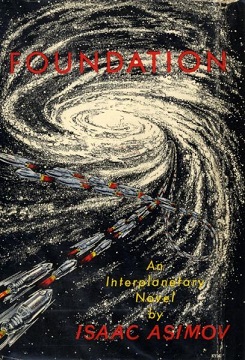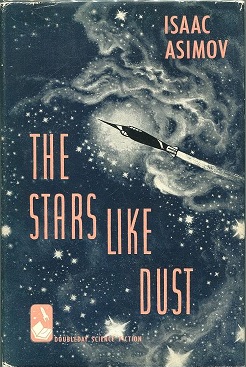External links
- "Dreaming Is a Private Thing" title listing at the Internet Speculative Fiction Database
| "Dreaming Is a Private Thing" | |
|---|---|
| Short story by Isaac Asimov | |
| Country | United States |
| Language | English |
| Genre(s) | Science fiction |
| Publication | |
| Published in | The Magazine of Fantasy and Science Fiction |
| Publication type | Periodical |
| Publisher | Fantasy House |
| Media type | Print (Magazine) |
| Publication date | December 1955 |
"Dreaming Is a Private Thing" is a science fiction short story by American writer Isaac Asimov, first published in the December 1955 issue of The Magazine of Fantasy and Science Fiction and reprinted in the 1957 collection Earth Is Room Enough . Asimov's original title for the story was "A Hundred Million Dreams at Once", but F&SF editor Anthony Boucher changed it. Asimov liked the new title and decided to keep it.
Jesse Weill is founder and owner of Dreams Inc, a company that produces dreams for the individual's private use, just as films used to be viewed, although they've been superseded by 'dreamies'. Dreamies can be viewed in private at home by anyone with the equipment and cash to buy or rent them (like present day videos or DVDs). They are produced by specially trained individuals, often social loners or eccentrics as a result of their intensive training over many years.
Weill is shown a new development—under-the-counter pornographic dreamies—and asked by the government to assist in cracking down on them. Meanwhile, he interviews a ten-year-old boy as a potential dreamer, a lucrative occupation if he turns out to be suitable and undergoes training.
He also gets told by one of his best dreamers that he does not want to work any more, as it is ruining family life; the dreamer also feels he has lost himself. But Weill knows from experience that the dreamer can't stop dreaming once he's become used to that way of life, even if he wants to.
One of Weill's staff tells him that a competing company is opening a chain of 'dream palaces', where everyone can absorb the same dream simultaneously, but he is of the opinion that it will not work. As he says, dreaming is a private thing.

Alfred Elton van Vogt was a Canadian-born American science fiction writer. His fragmented, bizarre narrative style influenced later science fiction writers, notably Philip K. Dick. He was one of the most popular and influential practitioners of science fiction in the mid-twentieth century, the genre's so-called Golden Age, and one of the most complex. The Science Fiction Writers of America named him their 14th Grand Master in 1995.

Isaac Asimov was an American writer and professor of biochemistry at Boston University. During his lifetime, Asimov was considered one of the "Big Three" science fiction writers, along with Robert A. Heinlein and Arthur C. Clarke. A prolific writer, he wrote or edited more than 500 books. He also wrote an estimated 90,000 letters and postcards. Best known for his hard science fiction, Asimov also wrote mysteries and fantasy, as well as popular science and other non-fiction.

John Wood Campbell Jr. was an American science fiction writer and editor. He was editor of Astounding Science Fiction from late 1937 until his death and was part of the Golden Age of Science Fiction. Campbell wrote super-science space opera under his own name and stories under his primary pseudonym, Don A. Stuart. Campbell also used the pen names Karl Van Kampen and Arthur McCann. His novella Who Goes There? was adapted as the films The Thing from Another World (1951), The Thing (1982), and The Thing (2011).
The New Wave was a science fiction style of the 1960s and 1970s, characterized by a great degree of experimentation with the form and content of stories, greater imitation of the styles of non-science fiction literature, and an emphasis on the psychological and social sciences as opposed to the physical sciences. New Wave authors often considered themselves as part of the modernist tradition of fiction, and the New Wave was conceived as a deliberate change from the traditions of the science fiction characteristic of pulp magazines, which many of the writers involved considered irrelevant or unambitious.

The Foundation series is a science fiction book series written by American author Isaac Asimov. First published as a series of short stories and novellas in 1942–50, and subsequently in three books in 1951–53, for nearly thirty years the series was widely known as The Foundation Trilogy: Foundation (1951), Foundation and Empire (1952), and Second Foundation (1953). It won the one-time Hugo Award for "Best All-Time Series" in 1966. Asimov later added new volumes, with two sequels, Foundation's Edge (1982) and Foundation and Earth (1986), and two prequels, Prelude to Foundation (1988) and Forward the Foundation (1993).

The Three Laws of Robotics are a set of rules devised by science fiction author Isaac Asimov, which were to be followed by robots in several of his stories. The rules were introduced in his 1942 short story "Runaround", although similar restrictions had been implied in earlier stories.

The Thing from Another World, sometimes referred to as just The Thing, is a 1951 American black-and-white science fiction-horror film directed by Christian Nyby, produced by Edward Lasker for Howard Hawks' Winchester Pictures Corporation, and released by RKO Radio Pictures. The film stars Margaret Sheridan, Kenneth Tobey, Robert Cornthwaite, and Douglas Spencer. James Arness plays The Thing. The Thing from Another World is based on the 1938 novella "Who Goes There?" by John W. Campbell.

Stanley Grauman Weinbaum was an American science fiction writer. His first story, "A Martian Odyssey", was published to great acclaim in July 1934; the alien Tweel was arguably the first character to satisfy John W. Campbell's challenge: "Write me a creature who thinks as well as a man, or better than a man, but not like a man." Weinbaum wrote more short stories and a few novels, but died from lung cancer less than a year and a half later.

The Naked Sun is a science fiction novel by American writer Isaac Asimov, the second in his Robot series. Like its predecessor, The Caves of Steel, this is a whodunit story. It was first published in book form in 1957 after being serialized in Astounding Science Fiction between October and December 1956.

The Stars, Like Dust is a 1951 science fiction mystery book by American writer Isaac Asimov.
"Robbie" is a science fiction short story by American writer Isaac Asimov. It was the first of Asimov's positronic robot stories. In 2016, "'Robbie" won a retrospective 1941 Hugo Award for best short story. "Robbie" was the fourteenth story written by Asimov, and the ninth to be published. It was the first story in Asimov's Robot series.

"The Last Question" is a science fiction short story by American writer Isaac Asimov. It first appeared in the November 1956 issue of Science Fiction Quarterly and in the anthologies in the collections Nine Tomorrows (1959), The Best of Isaac Asimov (1973), Robot Dreams (1986), The Best Science Fiction of Isaac Asimov (1986), the retrospective Opus 100 (1969), and in Isaac Asimov: The Complete Stories, Vol. 1 (1990). While he also considered it one of his best works, "The Last Question" was Asimov's favorite short story of his own authorship, and is one of a loosely connected series of stories concerning a fictional computer called Multivac. Through successive generations, humanity questions Multivac on the subject of entropy.
"The Dead Past" is a science fiction short story by American writer Isaac Asimov, first published in the April 1956 issue of Astounding Science Fiction. It was later collected in Earth Is Room Enough (1957) and The Best of Isaac Asimov (1973), and adapted into an episode of the science-fiction television series Out of the Unknown. Its pattern is that of dystopian fiction, but of a subtly nuanced flavor.

The Best Science Fiction of Isaac Asimov, published in 1986, is a collection of 28 short stories by American writer Isaac Asimov, personally selected as favorites by himself.
A feghoot is a humorous short story or vignette ending in a pun, where the story contains sufficient context to recognize the punning humor.

The literary genre of science fiction is diverse, and its exact definition remains a contested question among both scholars and devotees. This lack of consensus is reflected in debates about the genre's history, particularly over determining its exact origins. There are two broad camps of thought, one that identifies the genre's roots in early fantastical works such as the Sumerian Epic of Gilgamesh. A second approach argues that science fiction only became possible sometime between the 17th and early 19th centuries, following the scientific revolution and major discoveries in astronomy, physics, and mathematics.

Somnium — full title: Somnium, seu opus posthumum De astronomia lunari — is a novel written in Latin in 1608 by Johannes Kepler. It was first published in 1634 by Kepler's son, Ludwig Kepler, several years after the death of his father. In the narrative, an Icelandic boy and his witch mother learn of an island named Levania from a daemon. Somnium presents a detailed imaginative description of how the Earth might look when viewed from the Moon, and is considered the first serious scientific treatise on lunar astronomy. Carl Sagan and Isaac Asimov have referred to it as one of the earliest works of science fiction.

Before the Golden Age: A Science Fiction Anthology of the 1930s is an anthology of 25 science fiction stories from 1930s pulp magazines, edited by American science fiction writer Isaac Asimov. It also includes "Big Game", a short story written by Asimov in 1941 and never sold. The anthology was first published in April 1974, and won the 1975 Locus Award for Best reprint anthology.
"Breeds There a Man...?" is a science fiction short story by American writer Isaac Asimov. It was first published in the June 1951 issue of Astounding and was reprinted in science fiction anthologies such as Beachheads in Space (1952) and The Great SF Stories #13 (1951), as well as in Asimov-only collections such as Through a Glass, Clearly (1967), Nightfall and Other Stories (1969). and Robot Dreams (1986).
Astonishing Stories was an American pulp science fiction magazine, published by Popular Publications between 1940 and 1943. It was founded under Popular's "Fictioneers" imprint, which paid lower rates than Popular's other magazines. The magazine's first editor was Frederik Pohl, who also edited a companion publication, Super Science Stories. After nine issues Pohl was replaced by Alden H. Norton, who subsequently rehired Pohl as an assistant. The budget for Astonishing was very low, which made it difficult to acquire good fiction, but through his membership in the Futurians, a group of young science fiction fans and aspiring writers, Pohl was able to find material to fill the early issues. The magazine was successful, and Pohl was able to increase his pay rates slightly within a year. He managed to obtain stories by writers who subsequently became very well known, such as Isaac Asimov and Robert Heinlein. After Pohl entered the army in early 1943, wartime paper shortages led Popular to cease publication of Astonishing. The final issue was dated April of that year.